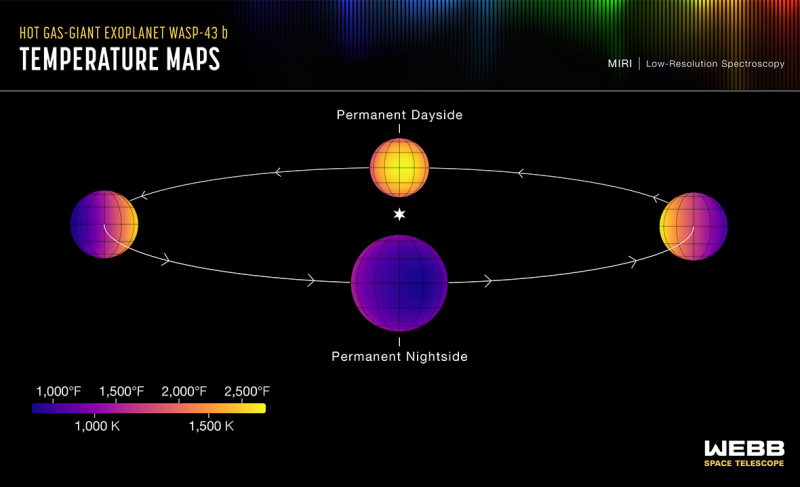
|
Credit & Copyright: Taylor Bell (BAERI),
Joanna Barstow (The Open University),
Michael Roman (University of Leicester)
Explanation:
A mere 280 light-years
from Earth,
tidally locked, Jupiter-sized exoplanet WASP-43b
orbits its parent star once every 0.8 Earth days.
That puts it about 2 million kilometers
(less than 1/25th the orbital distance of Mercury)
from a small, cool sun.
Still, on a dayside always facing its parent star, temperatures
approach a torrid 2,500 degrees F as measured at
infrared
wavelengths by the MIRI
instrument on board the James Webb Space Telescope.
In
this illustration
of the hot exoplanet's orbit, Webb
measurements also show nightside temperatures remain above 1,000 degrees F.
That suggests that strong equatorial
winds circulate the dayside
atmospheric gases to the nightside before they can completely cool off.
Exoplanet WASP-43b is now
formally known as
Astrol÷bos, and its K-type parent star has been christened Gnomon.
Webb's infrared spectra
indicate water vapor is present on the nightside as well as
the dayside of the planet, providing information about
cloud
cover on Astrol÷bos.
|
January February March April May June July August September October November December |
| ||||||||||||||||||||||||||||||||||||||||||||||||
NASA Web Site Statements, Warnings, and Disclaimers
NASA Official: Jay Norris. Specific rights apply.
A service of: LHEA at NASA / GSFC
& Michigan Tech. U.
Based on Astronomy Picture
Of the Day
Publications with keywords: extrasolar planet
Publications with words: extrasolar planet
See also:
- APOD: 2025 September 8 ┴ IRAS 04302: Butterfly Disk Planet Formation
- APOD: 2024 July 8 ┴ Exoplanet Zoo: Other Stars
- Epsilon Tauri: Star with Planet
- APOD: 2023 October 17 ┴ PDS 70: Disk, Planets, and Moons
- APOD: 2023 September 20 ┴ Methane Discovered on Distant Exoplanet
- APOD: 2023 June 6 ┴ Star Eats Planet
- APOD: 2023 February 1 ┴ The Seventh World of Trappist 1
